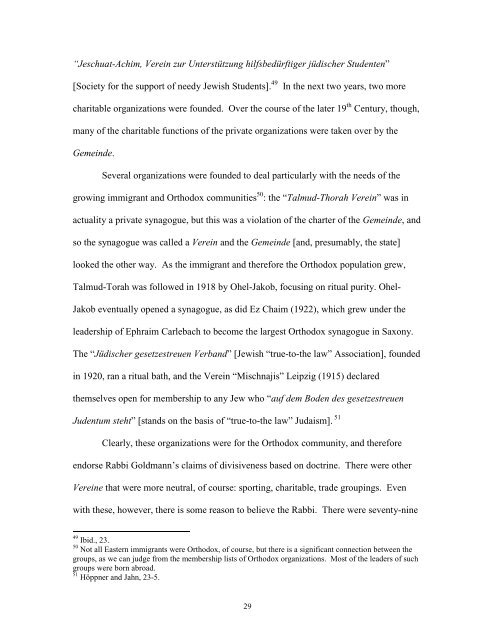Jews in Leipzig - The University of Texas at Austin
Jews in Leipzig - The University of Texas at Austin
Jews in Leipzig - The University of Texas at Austin
You also want an ePaper? Increase the reach of your titles
YUMPU automatically turns print PDFs into web optimized ePapers that Google loves.
“Jeschu<strong>at</strong>-Achim, Vere<strong>in</strong> zur Unterstützung hilfsbedürftiger jüdischer Studenten”<br />
[Society for the support <strong>of</strong> needy Jewish Students]. 49 In the next two years, two more<br />
charitable organiz<strong>at</strong>ions were founded. Over the course <strong>of</strong> the l<strong>at</strong>er 19 th Century, though,<br />
many <strong>of</strong> the charitable functions <strong>of</strong> the priv<strong>at</strong>e organiz<strong>at</strong>ions were taken over by the<br />
Geme<strong>in</strong>de.<br />
Several organiz<strong>at</strong>ions were founded to deal particularly with the needs <strong>of</strong> the<br />
grow<strong>in</strong>g immigrant and Orthodox communities 50 : the “Talmud-Thorah Vere<strong>in</strong>” was <strong>in</strong><br />
actuality a priv<strong>at</strong>e synagogue, but this was a viol<strong>at</strong>ion <strong>of</strong> the charter <strong>of</strong> the Geme<strong>in</strong>de, and<br />
so the synagogue was called a Vere<strong>in</strong> and the Geme<strong>in</strong>de [and, presumably, the st<strong>at</strong>e]<br />
looked the other way. As the immigrant and therefore the Orthodox popul<strong>at</strong>ion grew,<br />
Talmud-Torah was followed <strong>in</strong> 1918 by Ohel-Jakob, focus<strong>in</strong>g on ritual purity. Ohel-<br />
Jakob eventually opened a synagogue, as did Ez Chaim (1922), which grew under the<br />
leadership <strong>of</strong> Ephraim Carlebach to become the largest Orthodox synagogue <strong>in</strong> Saxony.<br />
<strong>The</strong> “Jüdischer gesetzestreuen Verband” [Jewish “true-to-the law” Associ<strong>at</strong>ion], founded<br />
<strong>in</strong> 1920, ran a ritual b<strong>at</strong>h, and the Vere<strong>in</strong> “Mischnajis” <strong>Leipzig</strong> (1915) declared<br />
themselves open for membership to any Jew who “auf dem Boden des gesetzestreuen<br />
Judentum steht” [stands on the basis <strong>of</strong> “true-to-the law” Judaism]. 51<br />
Clearly, these organiz<strong>at</strong>ions were for the Orthodox community, and therefore<br />
endorse Rabbi Goldmann’s claims <strong>of</strong> divisiveness based on doctr<strong>in</strong>e. <strong>The</strong>re were other<br />
Vere<strong>in</strong>e th<strong>at</strong> were more neutral, <strong>of</strong> course: sport<strong>in</strong>g, charitable, trade group<strong>in</strong>gs. Even<br />
with these, however, there is some reason to believe the Rabbi. <strong>The</strong>re were seventy-n<strong>in</strong>e<br />
49 Ibid., 23.<br />
50 Not all Eastern immigrants were Orthodox, <strong>of</strong> course, but there is a significant connection between the<br />
groups, as we can judge from the membership lists <strong>of</strong> Orthodox organiz<strong>at</strong>ions. Most <strong>of</strong> the leaders <strong>of</strong> such<br />
groups were born abroad.<br />
51 Höppner and Jahn, 23-5.<br />
29

















